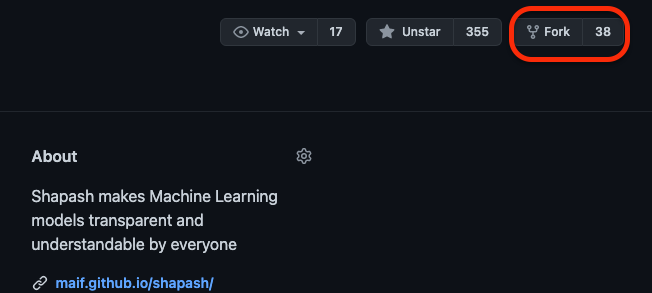This guide aims to help you contributing to Shapash. If you have found any problems, improvements that can be done, or you have a burning desire to develop new features for Shapash, please make sure to follow the steps bellow.
Screenshots are coming soon
An issue will open a discussion to evaluate if the problem / feature that you submit is eligible, and legitimate for Shapash.
Check on the project tab if your issue / feature is not already created. In this tab, you will find the roadmap of Shapash.
A Pull Request must be linked to an issue. Before you open an issue, please check the current opened issues to insure there are no duplicate. Define if it's a feature or a bugfix.
Next, the Shapash team, or the community, will give you a feedback on whether your issue must be implemented in Shapash, or if it can be resolved easily without a pull request.
The first step is to get our MAIF repository on your personal GitHub repositories. To do so, use the "Fork" button.
Click on the "Code" button to copy the url of your repository, and next, you can paste this url to clone your forked repository.
git clone https://github.com/YOUR_GITHUB_PROFILE/shapash.git
To insure that your local forked repository is synced, you have to update your repo with the master branch of Shapash (MAIF). So, go to your repository and as follow :
cd shapash
git remote add upstream https://github.com/MAIF/shapash.git
git pull upstream master
To contribute to Shapash, you will need to create a personal branch.
git checkout -b feature/my-contribution-branch
We recommand to use a convention of naming branch.
- feature/your_feature_name if you are creating a feature
- hotfix/your_bug_fix if you are fixing a bug
Before committing your modifications, we have some recommendations :
- Execute pytest to check that all tests pass
pytest
- Try to build Shapash
python setup.py bdist_wheel
- Check your code with flake8
We will soon add pre commit to automatically check your code quality during commit
flake8 . --count --exit-zero --max-complexity=10 --max-line-length=127 --statistics
In addition, we recommend committing with clear messages and grouping your commits by modifications dependencies.
Once all of these steps succeed, push your local modifications to your remote repository.
git add .
git commit -m ‘fixed a bug’
git push origin feature/my-contribution-branch
Your branch is now available on your remote forked repository, with your changes.
Next step is now to create a Pull Request so the Shapash Team can add your changes to the official repository.
A pull request allows you to ask the Shapash team to review your changes, and merge your changes into the master branch of the official repository.
To create one, on the top of your forked repository, you will find a button "Compare & pull request"
As you can see, you can select on the right side which branch of your forked repository you want to associate to the pull request.
On the left side, you will find the official Shapash repository.
- Base repository: MAIF/shapash
- Base branch: master
- Head repository: your-github-username/shapash
- Head branch: your-contribution-branch
Once you have selected the right branch, let's create the pull request with the green button "Create pull request".
In the description, a template is initialized with all informations you have to give about what you are doing on what your PR is doing.
Please follow this to write your PR content.
Your pull request is now ready to be submitted. A member of the Shapash team will contact you and will review your code and contact you if needed.
You have contributed to an Open source project, thank you and congratulations ! 🥳
Show your contribution to Shapash in your curriculum, and share it on your social media. Be proud of yourself, you gave some code lines to the entire world !




